7777 W. Bluemound Rd. P.O. Box 13819 Milwaukee, WI 53213 In Australia Contact:
Hal Leonard Australia Pty. Ltd. 4 Lentara Court Cheltenham, Victoria, 3192 Australia For all works contained herein: Unauthorized copying, arranging, adapting, recording, Internet posting,
public performance, or other distribution of the printed or recorded music
in this publication is an infringement of copyright. Infringers are liable under the law.
Visit Hal Leonard Online at www.halleonard.com PREFACE Saxophone Workout comes out of 25 years personal experience with the saxophone. Here youll find etudes that cover a wide spectrum of techniques, from the basics to intermediate level to advanced. With daily practice that includes use of a metronome and tuner, this book will provide noticeable improvement in the mastery of your horn. The exercises are designed for the trouble spots of all the instruments of the saxophone family soprano, alto, tenor, baritone. NOTES FOR USING THIS BOOK All the scales and exercises use the full range of the instrument. Most modern saxophones, and some older, have an added high F B key.
Most of these exercises are written up to F B . You can decide how high you want to practice either to high F or high F B . Please change any exercises accordingly. If your instrument doesnt have a high F B key, I have listed one fingering example. Practice or research other fingerings that work and feel most comfortable to you. Enharmonics have been used intermittently to help you learn and identify both note names: G B /A D , A B /B D , C B /D D , F B /G D , etc.
Always use a metronome at a comfortable tempo. I suggest starting all exercises slowly. Of course, you may start at whatever tempo is comfortable, but speed up only when you can play the exercise cleanly and flawlessly and with good tone. Try to memorize these patterns/exercises, learning them away from the book. Using mental practice versus reading helps you learn the etudes better for mental and fingering practice. Eventually, you can use the book as a reference on an as needed basis.
Alternate high E and high F front fingerings (non-palm-key fingerings) are variously referred to as alternate, forked, or plateau fingering. The term forked is used in this book. Practice all exercises using the various articulations shown below:
CHAPTER 1 RHYTHMS Rhythm is what sets the pulse of music, determining the placement of sound in time. The basic rhythmic units are the whole note, half note, quarter note, eighth note, and 16th note and their corresponding rests. Along with these, the rhythms given below are generally the ones you will see in music of all genres and style periods.
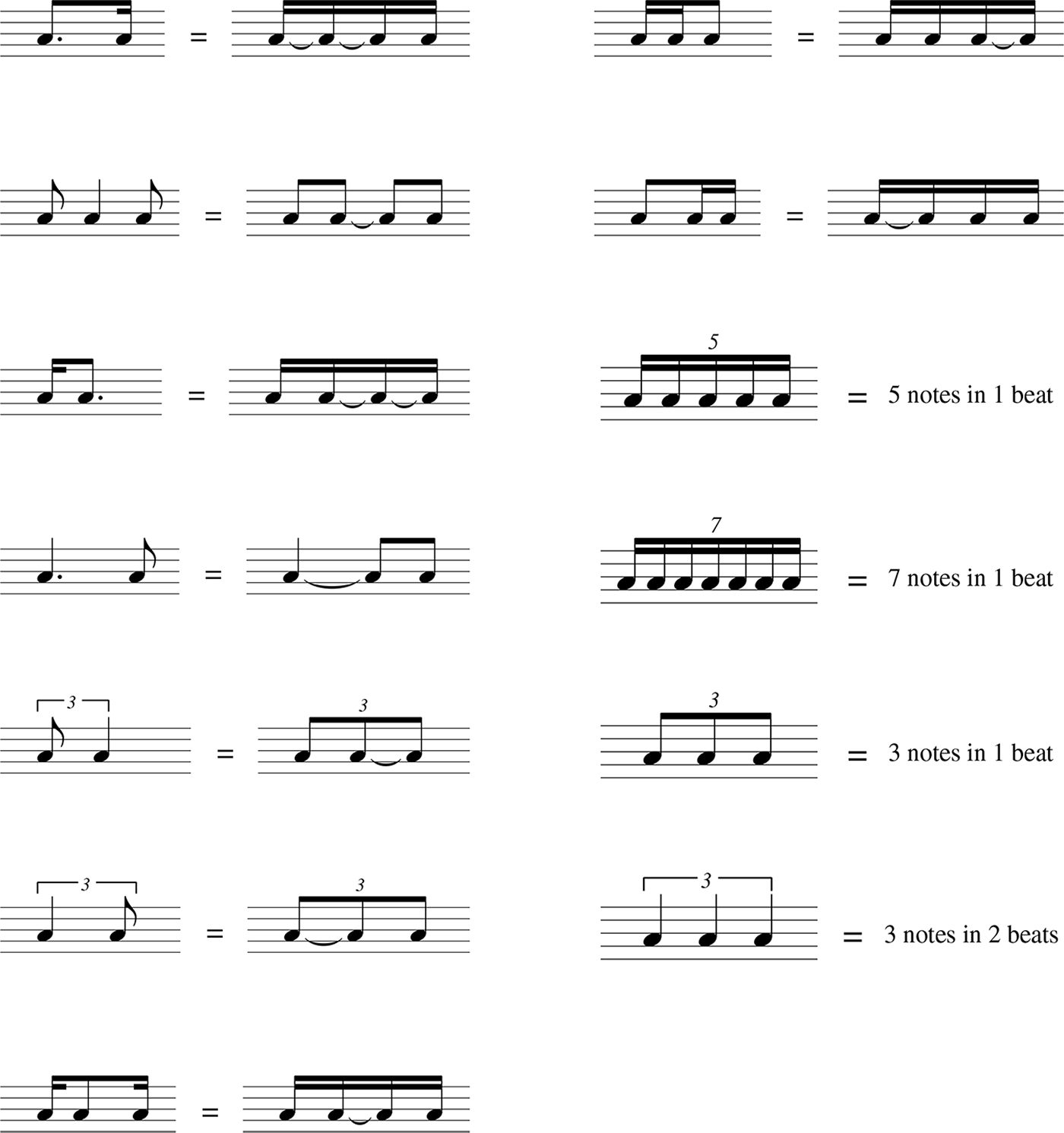
This exercise utilizes a variety of rhythms.

This exercise utilizes a variety of rhythms.
Practice with a metronome, making sure each rhythm is played correctly and in time. 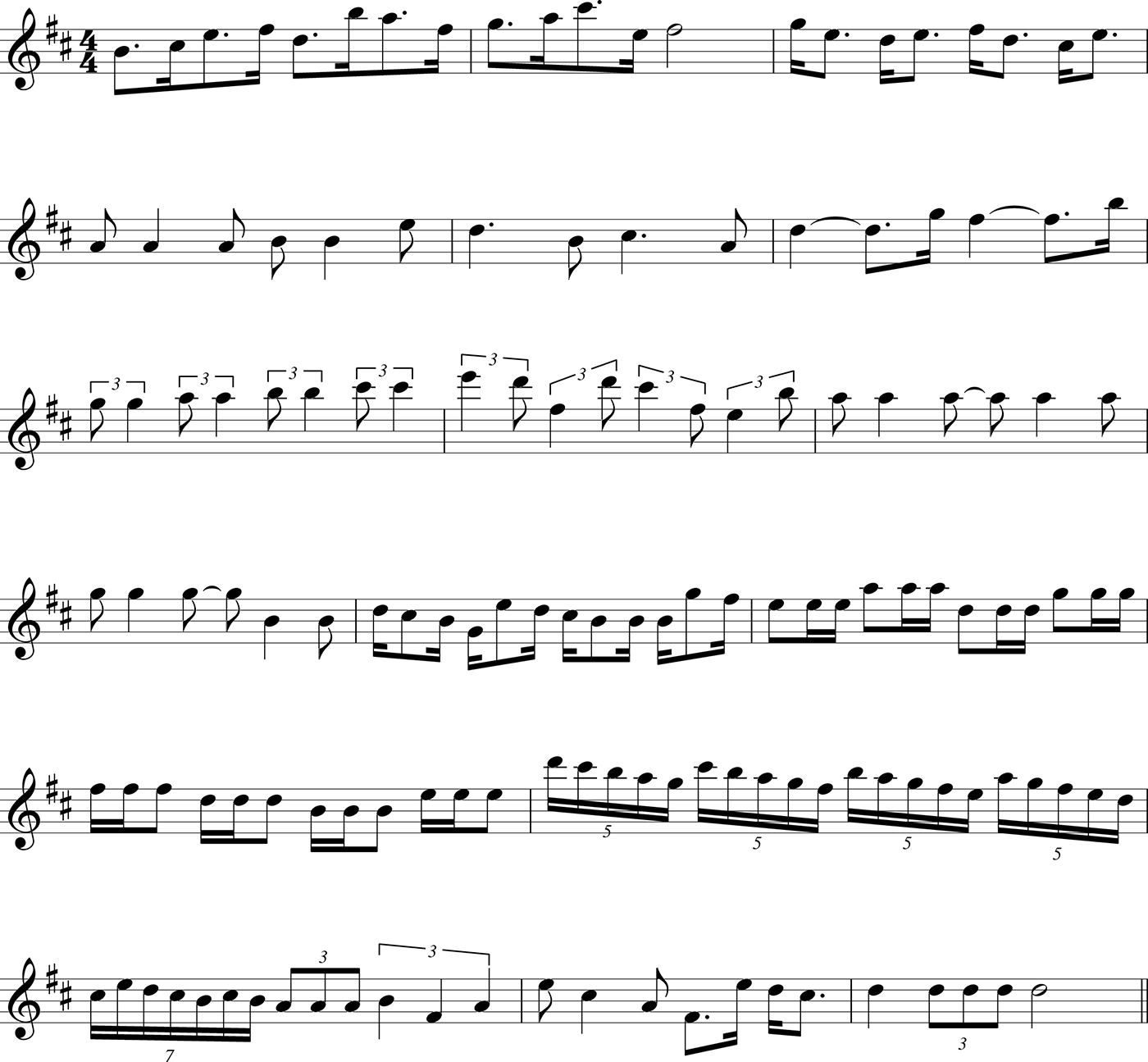 CHAPTER 2 TIME SIGNATURES Various time signatures are used throughout music, with 4/4 (common time) the most used and comfortable to play. Practice each exercise below, fully understanding how each individual rhythm is played and counted. If you are confident of all these rhythms in their respective time signatures, you will greatly improve your music reading skills.
CHAPTER 2 TIME SIGNATURES Various time signatures are used throughout music, with 4/4 (common time) the most used and comfortable to play. Practice each exercise below, fully understanding how each individual rhythm is played and counted. If you are confident of all these rhythms in their respective time signatures, you will greatly improve your music reading skills. 





 CHAPTER 3 ARTICULATIONS Articulations tell us how individual notes are to be played within a phrase or musical passage. In the Preface (page v), you were given various ways of slurring notes together or separating them with a staccato articulation.
CHAPTER 3 ARTICULATIONS Articulations tell us how individual notes are to be played within a phrase or musical passage. In the Preface (page v), you were given various ways of slurring notes together or separating them with a staccato articulation.
Along with staccato, we have other means of articulation: tenuto, accent, and marcato. These are shown below.  Staccato: The note is to be played shorter than notated. Staccato marks may appear on notes of any value, shortening their performed duration without speeding the music itself. Tenuto: A note should be played for its full value, or slightly longer; it may also indicate a slight dynamic emphasis. Accent: The note is played louder or with a harder attack than surrounding unaccented notes.
Staccato: The note is to be played shorter than notated. Staccato marks may appear on notes of any value, shortening their performed duration without speeding the music itself. Tenuto: A note should be played for its full value, or slightly longer; it may also indicate a slight dynamic emphasis. Accent: The note is played louder or with a harder attack than surrounding unaccented notes.
Accents can appear on notes of any duration. Marcato: The note is played somewhat louder or more forcefully than a note with a regular accent mark. The following melody incorporates all four of these articulations, as well as a set of slurred 16th notes. Practice with a metronome to ensure a steady beat.  This A major tune adds triplets to the rhythmic mix.
This A major tune adds triplets to the rhythmic mix.  CHAPTER 4 LOW NOTES (Pinky Workout) Practice all low-note exercises slowly.
CHAPTER 4 LOW NOTES (Pinky Workout) Practice all low-note exercises slowly.  CHAPTER 4 LOW NOTES (Pinky Workout) Practice all low-note exercises slowly.
CHAPTER 4 LOW NOTES (Pinky Workout) Practice all low-note exercises slowly.
Use a metronome to ensure a steady beat and a tuner to make sure each note is clean and clear. Always leave your pinky on the keys, using the black-key rollers to move between notes. You can also experiment with shifting your left wrist downward. Use tonguing and slurring. 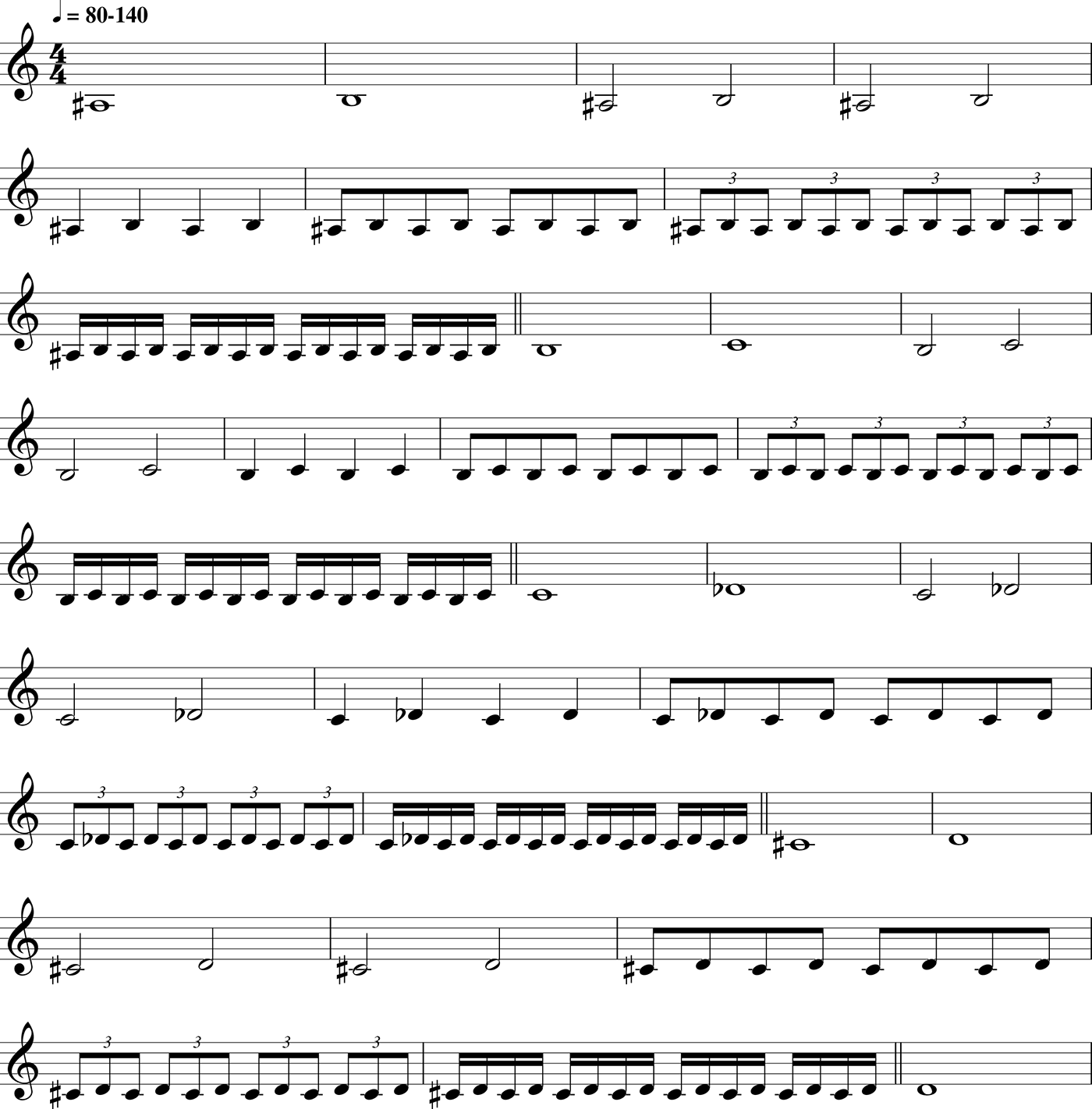


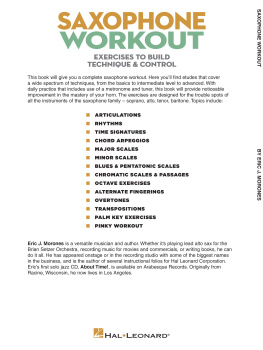


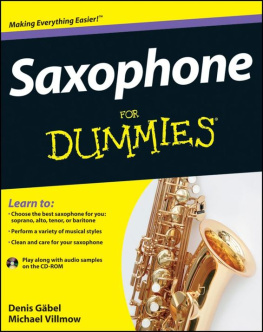







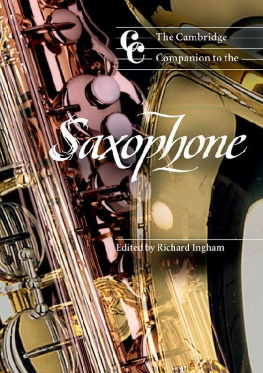



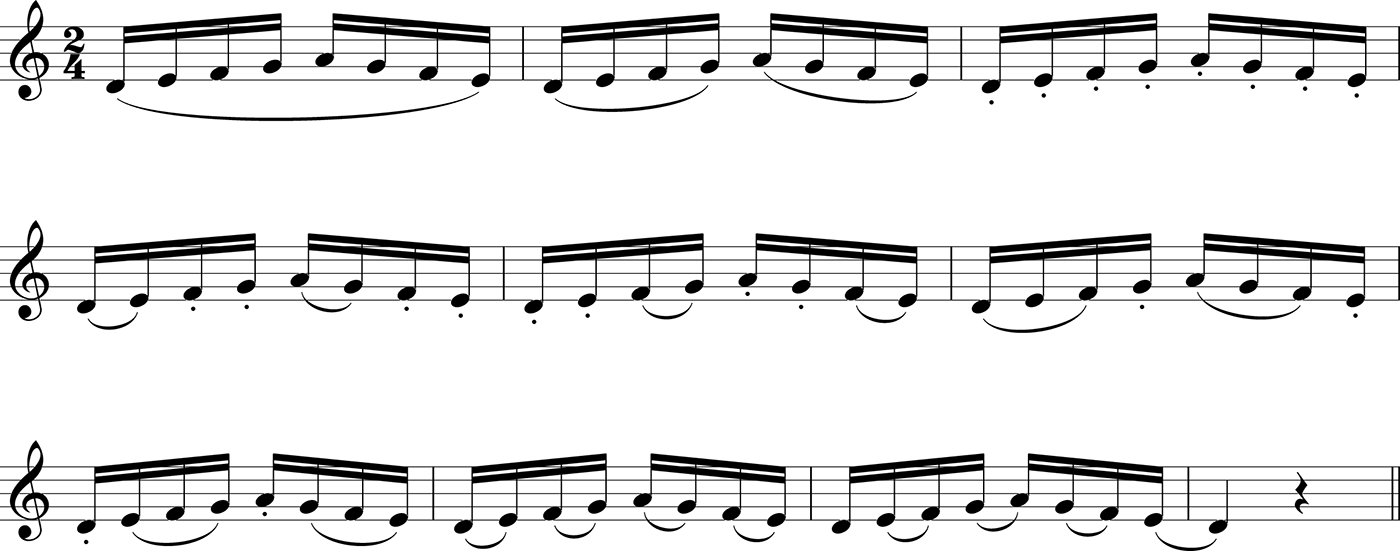
 This exercise utilizes a variety of rhythms.
This exercise utilizes a variety of rhythms.  CHAPTER 2 TIME SIGNATURES Various time signatures are used throughout music, with 4/4 (common time) the most used and comfortable to play. Practice each exercise below, fully understanding how each individual rhythm is played and counted. If you are confident of all these rhythms in their respective time signatures, you will greatly improve your music reading skills.
CHAPTER 2 TIME SIGNATURES Various time signatures are used throughout music, with 4/4 (common time) the most used and comfortable to play. Practice each exercise below, fully understanding how each individual rhythm is played and counted. If you are confident of all these rhythms in their respective time signatures, you will greatly improve your music reading skills. 





 CHAPTER 3 ARTICULATIONS Articulations tell us how individual notes are to be played within a phrase or musical passage. In the Preface (page v), you were given various ways of slurring notes together or separating them with a staccato articulation.
CHAPTER 3 ARTICULATIONS Articulations tell us how individual notes are to be played within a phrase or musical passage. In the Preface (page v), you were given various ways of slurring notes together or separating them with a staccato articulation. Staccato: The note is to be played shorter than notated. Staccato marks may appear on notes of any value, shortening their performed duration without speeding the music itself. Tenuto: A note should be played for its full value, or slightly longer; it may also indicate a slight dynamic emphasis. Accent: The note is played louder or with a harder attack than surrounding unaccented notes.
Staccato: The note is to be played shorter than notated. Staccato marks may appear on notes of any value, shortening their performed duration without speeding the music itself. Tenuto: A note should be played for its full value, or slightly longer; it may also indicate a slight dynamic emphasis. Accent: The note is played louder or with a harder attack than surrounding unaccented notes. This A major tune adds triplets to the rhythmic mix.
This A major tune adds triplets to the rhythmic mix.  CHAPTER 4 LOW NOTES (Pinky Workout) Practice all low-note exercises slowly.
CHAPTER 4 LOW NOTES (Pinky Workout) Practice all low-note exercises slowly. 
